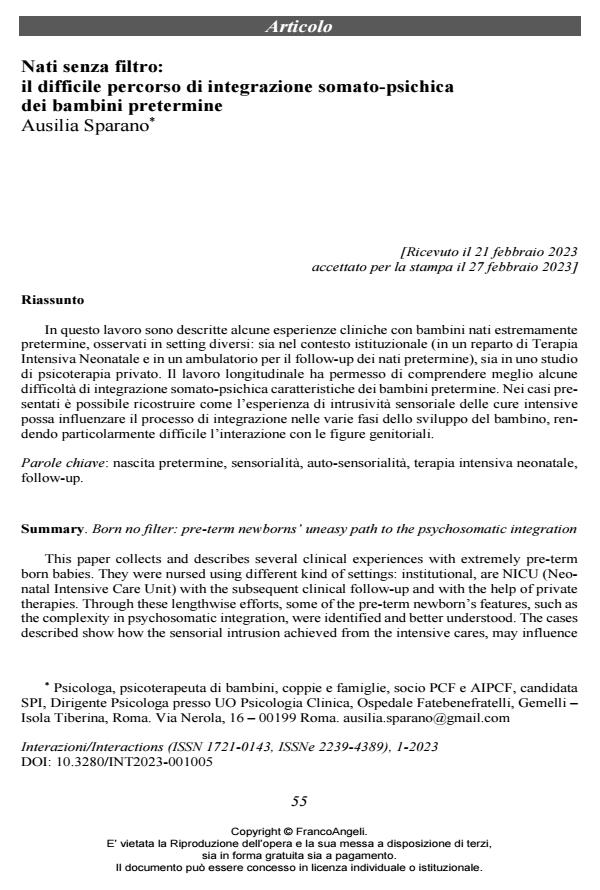Born no filter: pre-term newborns’ uneasy path to the psychosomatic integration
Journal title INTERAZIONI
Author/s Ausilia Sparano
Publishing Year 2023 Issue 2023/1
Language Italian Pages 17 P. 55-71 File size 212 KB
DOI 10.3280/INT2023-001005
DOI is like a bar code for intellectual property: to have more infomation
click here
Below, you can see the article first page
If you want to buy this article in PDF format, you can do it, following the instructions to buy download credits

FrancoAngeli is member of Publishers International Linking Association, Inc (PILA), a not-for-profit association which run the CrossRef service enabling links to and from online scholarly content.
This paper collects and describes several clinical experiences with extremely pre-term born babies. They were nursed using different kind of settings: institutional, are NICU (Neonatal Intensive Care Unit) with the subsequent clinical follow-up and with the help of private thera-pies. Through these lengthwise efforts, some of the pre-term newborn’s features, such as the complexity in psychosomatic integration, were identified and better understood. The cases de-scribed show how the sensorial intrusion achieved from the intensive cares, may influence the integration process as the newborn’s development further up, entangling the parental interac-tions.
Keywords: preterm born, sensoriality, sensory self, Neonatal Intensive Care Unit, follow-up.
- Anzieu D. (1985). L’Io-Pelle. Milano: Raffello Cortina, 2017.
- Ansermet F., Magistretti P. (2007). A ciascuno il suo cervello. Plasticità neuronale e inconscio. Torino: Bollati Boringhieri, 2008.
- Bick E. (1968). L’esperienza della pelle nelle prime relazioni oggettuali. Torino: Boringhieri, 1974.
- Bion W. (1962). Apprendere dall’esperienza. Roma: Armando (1972).
- Erygit-Madzwamuse S., et al. (2015). Personality of adults who were born very preterm. Archives of Disease in Childhood-Fetal and Neonatal Edition, 100, 6: F524-F529.
- Feldman R., Rosenthal Z., Eidelman A. (2014). Maternal-preterm skin-to-skin contact enhances child physiologic organization and cognitive control across the first 10 years of life. Biological Psychiatry, 75, 1: 56-64.
- Feldman R., Eidelman A. (2007). Maternal postpartum behavior and the emergence of infant–mother and infant–father synchrony in preterm and full-term infants: The role of neonatal vagal tone. Developmental Psychobiology, 49, 3: 290-302.
- Fraiberg S. (1999). Il sostegno allo sviluppo. Milano: Raffello Cortina, 1999.
- Freud A. (1961). L’Io e i meccanismi di difesa. Firenze: Martinelli, 1967.
- Freud S. (1919). Il perturbante. OSF, vol. 9. Torino: Bollati Boringhieri.
- Freud S. (1922). L’Io e l’Es. OSF, vol. 9. Torino: Bollati Boringhieri.
- Gaddini E. (1989). Scritti. Milano: Raffello Cortina, 1989.
- Gallese V. (2022). Simulazione incarnata, Sé, Altro e Performatività. In Nicolò A.M. et al. (a cura di), La mente sensoriale. Milano: FrancoAngeli.
- Golse B. (2016). Des sens au sens: la place de la sensorialité. Eprouver, percevoir, construire. Revue Française de Psychanalyse, 80, 4: 998-1011.
- Imbasciati A., Cena L. (2010). I bambini e i loro caregivers. Roma: Borla.
- Jefferies A., Canadian Paediatric Society, Fetus and Newborn Committee (2012). Kangaroo care for the preterm infant and family. Paediatrics & Child Health, 17, 3: 141-143.
- Jouen F. et al. (2017). Epigenese probabiliste et developpement. In Candilis-Huisman D., Dugnant M. (Ed), Bébé sapiens. Toulouse: Arip/Erès.
- Melzer D. et al. (1975). Esplorazioni sull’autismo. Torino: Boringhieri, 1977.
- Negri R. (2017). Personalità e memoria fetale. Relazione presentata al X Congresso internazionale sull’Infant Observation secondo E. Bick e le sue applicazioni (AIDOBB), 2-5 novembre 2017.
- Piontelli A. (1992). From fetus to child. London: Routledge.
- Salomonsson B. (2015). Brevi ma profonde. Consultazioni psicoanalitiche nel Centro Pediatrico Mama Mia. Interazioni, 1, 41: 11-19. DOI: 10.3280/INT2015-001002
- Soulè M., Soubieux M.-J. (2005). La psichiatria fetale (a cura di L. Rizzo). Milano: FrancoAngeli, 2007.
- Stern D.N. (1989). Le interazioni affettive. In Lebovici S., Weil-Halpern F. (a cura di), Psicopatologia della prima infanzia vol. 1: Il mondo del neonato. Torino: Bollati Boringhieri, 1994.
- Tustin F. (1981). Gli stati autistici nei bambini. Roma: Armando.
- Van Der Kolk B. (2015). Il corpo accusa il colpo. Mente, corpo e cervello nell’elaborazione delle memorie traumatiche. Milano: Raffaello Cortina.
- Winnicott D.W. (1985). Dalla pediatria alla psicoanalisi. Firenze: Martinelli.
Ausilia Sparano, Nati senza filtro: il difficile percorso di integrazione somato-psichica dei bambini pretermine in "INTERAZIONI" 1/2023, pp 55-71, DOI: 10.3280/INT2023-001005